|
Recollecting Andrey Avinoff
By Louise Lippincott, Chief Curator and Curator of Fine Arts, Carnegie Museum of Art
Andrey Avinoff was director of Carnegie Museum of Natural History when he made this remark to his nephew Nicholas Shoumatoff. From 1926 to 1945, between 9 a.m. and 5 p.m. daily, Avinoff practiced, exhibited, and taught science to thousands of museum visitors, and his work shaped the museum in important ways. Today, however, Carnegie Museum of Art is most interested in those “other ideas” he entertained after 5 p.m., as we embark on a project to learn more about them.
Parnassius tianschanicus. photo: Jane C. Hyland
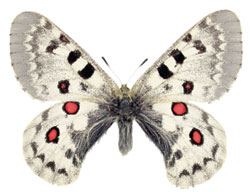 A man of extraordinary intelligence, compulsively productive, and obsessed with the beauty of the exquisite, Avinoff became world-renowned for his scientific work on butterflies (see page 30). Some Pittsburghers were also aware of his artistic talent, as expressed in his occasional illustrations for CARNEGIE magazine and charming designs for Christmas cards, bookplates, banquet menus, and personal gifts. What they didn’t know is that before his appointment to the museum, Avinoff had made a living as a commercial illustrator, and that beginning in the 1930s, he began a second career, parallel to his day job at the museum, as a visionary artist. A man of extraordinary intelligence, compulsively productive, and obsessed with the beauty of the exquisite, Avinoff became world-renowned for his scientific work on butterflies (see page 30). Some Pittsburghers were also aware of his artistic talent, as expressed in his occasional illustrations for CARNEGIE magazine and charming designs for Christmas cards, bookplates, banquet menus, and personal gifts. What they didn’t know is that before his appointment to the museum, Avinoff had made a living as a commercial illustrator, and that beginning in the 1930s, he began a second career, parallel to his day job at the museum, as a visionary artist.
In the summer of 2007, Avinoff’s four heirs, grandchildren of his sister Elizabeth Shoumatoff, approached the two Carnegie Museums in Oakland about a project to document and preserve their great uncle’s life and work. Carnegie Museum of Art owned one small watercolor, a simple still life of begonias, given in the 1950s. Carnegie Museum of Natural History, it turned out, still owned his massive collections of butterflies and scientific books, as well as more than 400 botanical watercolors. We had no idea.
We had no idea that Avinoff had been a talented and superbly trained draftsman and watercolorist since childhood. According to family history, his youth in Russia was filled with drawings and entomological specimens. He learned watercolor technique from a family governess, and attended art school as a young man while pursuing his avocation for science, and a degree in law. Avinoff’s early watercolors are typical of turn-of-the-century style and technique, combining seemingly effortless execution with a sophisticated approach to composition.
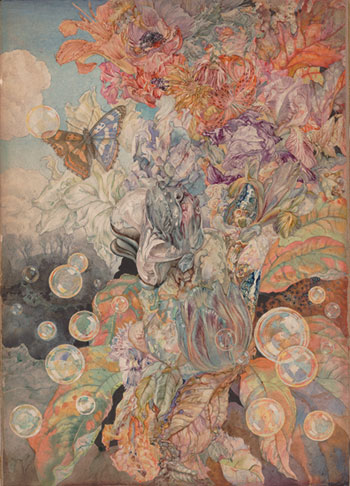 From the very beginning, Avinoff’s work served both art and science. Among his earliest surviving watercolors is a set of views made during his trips to collect butterflies in northern India, Kashmir, and western Tibet in 1908 and 1912. The view from the interior of his tent in the Karakoram Mountains artfully foregrounds the clutter of Western civilization—revolver, whiskey bottle, pith helmet, and leather-bound trunks—against a barren, pitiless background of rock and snow. Of no obvious scientific value, it provides a vivid sense of the experience of sitting in a canvas tent on a stony riverbank somewhere in the mountains of western Asia at the beginning of the 20th century. On the back of the sheet we discovered brilliantly colored drawings of butterfly wings, evidently made for study, arranged on the page with no concern at all for symmetry or aesthetics. From the very beginning, Avinoff’s work served both art and science. Among his earliest surviving watercolors is a set of views made during his trips to collect butterflies in northern India, Kashmir, and western Tibet in 1908 and 1912. The view from the interior of his tent in the Karakoram Mountains artfully foregrounds the clutter of Western civilization—revolver, whiskey bottle, pith helmet, and leather-bound trunks—against a barren, pitiless background of rock and snow. Of no obvious scientific value, it provides a vivid sense of the experience of sitting in a canvas tent on a stony riverbank somewhere in the mountains of western Asia at the beginning of the 20th century. On the back of the sheet we discovered brilliantly colored drawings of butterfly wings, evidently made for study, arranged on the page with no concern at all for symmetry or aesthetics.
Above: Andrey Avinoff, The Chrysalis: Passage of the Flight of Time, c. 1920–1930,
Bequest of Howard A. Noble, by exchange, and the Margaret M. Vance Fund
We had no idea that while Avinoff was synthesizing the scientific information from his butterfly collections into a sophisticated theory of evolution and speciation he was also expressing his ideas about metamorphosis, transience, and change in weird, fantastical, and beautiful watercolor paintings.
Perhaps the most telling of these is an undated composition known as Iridescence or The Chrysalis: Passage of the Flight of Time. It seems to have been executed following Avinoff’s emigration to the United States in 1916, but probably before his appointment as director of the Museum of Natural History in 1926.
The center of the composition is a complicated mass of biomorphic forms, some like flowers, some like butterfly chrysalides, and others that suggest the physiognomies (facial features) of humans and frogs. Flowing out of this organic mass are richly colored flowers, decaying autumnal leaves, a single shimmering butterfly (Apatura ilia), and a flight of iridescent soap bubbles. In the background: a dark landscape of barren trees and a sunny blue sky filled with clouds. Although we are far from understanding the meaning of this visionary image, it seems likely that its underlying messages—the unity and interconnectedness of life, the fragility and endless creativity of nature—are related to the underlying convictions of Avinoff’s scientific work as well.
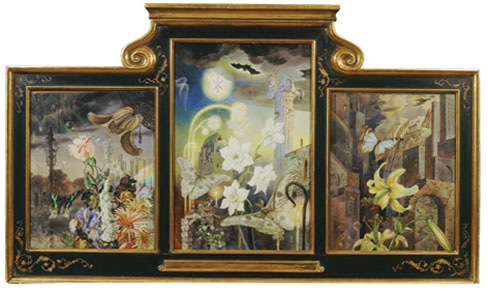
Andrey Avinoff, The Dispensation of the Old and the New, 1941–1947, Heinz Family Fund
And we had no idea that, beginning in the 1930s—probably while hearing of the horrors of Stalinism in his native Russia and experiencing the crushing effects of economic depression in the United States and the onset of war in Europe—he began to extend his theories of evolution, change, decay, and metamorphosis to human history and his own life story. These seem to be the themes of his last masterpiece, a triptych of three watercolors titled The Dispensation of the Old and the New (above), begun in 1941, shortly after Pearl Harbor, and completed in 1947.
The story of this three-paneled painting begins at a Pittsburgh debutante party in December 1941. The debutante in question recalled that Avinoff admired her corsage and asked her if he could have the flowers to paint. She handed them over gladly, and to her pleased surprise he sent her an elegant watercolor sketch of the Star of Bethlehem blossoms and a Christmas card reproducing an elaborate composition based on her flowers. The original art for the Christmas card would become the central panel of the triptych. The side panels, smaller in size and darker in tone than the central image, seem to have been added in 1947, after Avinoff retired from the museum and moved to New York City.
Avinoff composed his triptych in the same manner that his staff at the Museum of Natural History designed the astonishingly lifelike dioramas he popularized in the 1930s and 1940s. Beautifully presented natural specimens dominate the foregrounds, while illusionistic backgrounds re-create the subjects’ environment.
In the case of the triptych, however, the connections between foregrounds (flowers, moths, and a butterfly) and backgrounds are symbolic, not natural. Thus, in the center panel, we have Star of Bethlehem flowers and two Asian moths (Eriogyna pyretorum) in front of the ruins of Tamerlane’s mausoleum in Samarkand and a column from the mausoleum of Helicarnassus (of which there is a cast in Carnegie Museum of Art’s Hall of Architecture). The flowers, combined with the starry objects in the sky, the shepherd’s crook, angel wings, and lifting clouds, allude to the coming of Christianity, set against the crumbling remains of the pagan empires of Asia and Europe.
The side panels seem to have the most personal significance to Avinoff. In the panel on the right, a yellow lily and a butterfly (Morpho aega) dominate an architectural background comprised of a ruined arch, a medieval-style church, and skyscrapers; in the background, the cliffs of western Tibet and a Buddhist monastery from which flows the River of Life. Considered as a diorama, the panel positions the viewer in the modern West looking back to the mystical East.
The left-hand panel seems to reverse the point of view, now going from East to distant West. In the foreground, an iris, rose, pansy, and other flowers surround a porcelain statue of Kuan Yin, Buddhist goddess of compassion; she materializes in three other parts of the scene as well. Two moths hover nearby (a Brazilian Rhescyntis pseudomartii on the right; a Madagascar Chrysiridia rhipheus on the left). Swags of black lace in the upper corners probably symbolize the Iron Curtain separating East from West. In the distance, the River of Life has broadened and slowed; beyond it stand the desolate trees and profiled skyscrapers of New York’s Central Park.
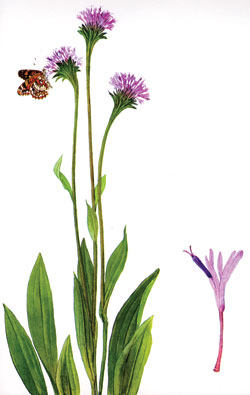 In spite of the progress we have made identifying elements of the triptych, we are still struggling to decipher its meaning. What do the flowers, moths, and butterflies symbolize? Are the atmospheric effects of clouds, rainbows, light, and dark significant? Do the floating soap bubbles allude to transience, as they had in the 1920s? How do we interpret the Christian and Buddhist symbols? Do the references to Tibet and New York and the River of Life relate to Avinoff’s travels and life story? We have, as yet, no idea. In spite of the progress we have made identifying elements of the triptych, we are still struggling to decipher its meaning. What do the flowers, moths, and butterflies symbolize? Are the atmospheric effects of clouds, rainbows, light, and dark significant? Do the floating soap bubbles allude to transience, as they had in the 1920s? How do we interpret the Christian and Buddhist symbols? Do the references to Tibet and New York and the River of Life relate to Avinoff’s travels and life story? We have, as yet, no idea.
More than 700 paintings and drawings by Avinoff’s hand are known. The ones he made after 5 p.m. extend the hard facts and tested theories of science into the imaginative realms of art, philosophy, religion, history, and personal life.
We had no idea.
My thanks to John Rawlins, associate curator of invertebrate zoology at Carnegie Museum of Natural History, for his identifications of moths and butterflies, and our helpful conversations about Avinoff as an entomologist. Bernadette Callery, Museum of Natural History librarian, has been an enthusiastic co-conspirator all along. My thanks also to the Avinoff heirs, who have generously shared their knowledge and collections with me.
Above: Watercolor by Andrey Avinoff. Marshallia (Marshallia grandiflora),
Wild Flowers of Western Pennsylvania and the Upper Ohio Basin, 1953
Andrey Avinoff: Master of Arts and Sciences
By John Rawlins, Associate Curator of Invertebrate Zoology,
Carnegie Museum of Natural History
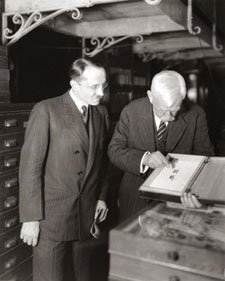 America is a land of emigrants; people from everywhere sharing their talents and ideas. One remarkable contributor to this “melting pot” in Pittsburgh was Andrey Avinoff, a Russian emigré of great intellect, artistic ability, and linguistic facility. Avinoff led the renowned Carnegie Museum of Natural History as its director for nearly 20 challenging years of the Great Depression and Second World War, from 1926 to 1945. Arriving in Pittsburgh in 1924, Avinoff was recognized as a skilled curator of entomology and a talented illustrator of natural history subjects. Avinoff’s poise, wit, and cultural interests, coupled with his zeal for arts and natural history, made him an indispensable guest at social gatherings with museum benefactors and Pittsburgh’s cultural elite. America is a land of emigrants; people from everywhere sharing their talents and ideas. One remarkable contributor to this “melting pot” in Pittsburgh was Andrey Avinoff, a Russian emigré of great intellect, artistic ability, and linguistic facility. Avinoff led the renowned Carnegie Museum of Natural History as its director for nearly 20 challenging years of the Great Depression and Second World War, from 1926 to 1945. Arriving in Pittsburgh in 1924, Avinoff was recognized as a skilled curator of entomology and a talented illustrator of natural history subjects. Avinoff’s poise, wit, and cultural interests, coupled with his zeal for arts and natural history, made him an indispensable guest at social gatherings with museum benefactors and Pittsburgh’s cultural elite.
Above: Andrey Avinoff with William Jacob Holland, who preceded him as Natural History director.
But Avinoff was not just exceptional for his curatorial or administrative roles or for productivity as an artist, but also as a scientist with avocational training in his favorite group, Lepidoptera (moths and butterflies). He had a passionate appreciation for the romantic aspects of studying butterflies and moths, and detailed knowledge resulting from experiences in Central Asia and as curator at the Museum of Natural History. Avinoff began collecting butterflies as a youth in Ukraine. By the time he escaped Lenin’s Bolsheviks in the Russian Revolution of 1917, his collection was of large size and great scientific value. Most specimens were preserved in the Zoological Institute of the Russian Academy of Sciences in St. Petersburg. In Pittsburgh, Avinoff’s passion for Lepidoptera could not be suppressed, and he began to accum-ulate the second Avinoff Collection, now a unique treasure of the museum.
Avinoff had lifelong enthusiasm for the fauna of his homeland, especially those from the mountains to the east. Extending from Afghanistan to northern China, this is one of Earth’s most spectacular regions, a vast landscape filled with desert mountains subject to long freezing winters and brief cool summers, inhabited by butterflies displaying a seemingly endless array of sizes, colors, and patterns. Each range has its own populations comprised of similar individuals, differing slightly from those on adjacent mountains, and ever more different from those at greater distance.
Avinoff knew this region’s confusing panoply of features was not merely the whimsy of a divine being, but rather the outcome of historical events that influenced the movement of butterflies between mountains over time. Consequently, his fascination with how populations vary in space over time (geographical variation) would become the research question motivating Avinoff throughout his life: Where did they come from, and in what sequence did they appear in the Asian mountains he so loved?
Avinoff’s entomological research reflects his affaire d’amour with geographical variation. His first liaison was with gossamer-winged butterflies in the genus Parnassius. Avinoff focused on studying the countless forms and subspecies named by Russian and European specialists. Comparing specimens from precise localities with new material taken in previously uncollected regions, he discovered new forms and gave them names. He realized that to understand the origin of geographical variation, many specimens were needed from many localities. He knew well the answer to a query frequently voiced at large museums, “Why do you need so many?”
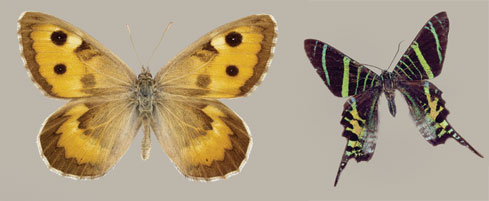
Left: Karanasa pamira ornata Right: Urania sloanus. photo: Jane C. Hyland
During the 1930s, Avinoff’s romance with collecting Lepidoptera and studying geography continued on the Caribbean island of Jamaica. Identifying butterflies was easy, but the moths proved more challenging despite Avinoff’s efforts to classify specimens by comparing them with the collections in the British Museum in London. But just as Avinoff had observed variation between forms on “sky islands” in Asia, he witnessed differences between oceanic islands in the Caribbean. Some populations were species distinct from mainland forms, endemic to Jamaica. Others were thought to be Jamaican varieties of species widespread elsewhere. Avinoff was sensitive to the fate of endemic species threatened by habitat loss, and he documented such rarities as the Jamaican giant swallowtail (Papilio homerus) and Sloane’s urania moth (Urania sloanus), now extinct.
Avinoff’s final amour with geographical variation involved another group of Asian butterflies, the genus Karanasa. As with the Parnassius, he found great variation in color, pattern, and genitalia, complicating decisions as to which were species and which were not. Avinoff understood that local populations were best suited for studying variation. He had marveled how two species could occur in the same location without intergrading, yet on adjacent mountains the two intergraded, their differences melding together as one interbreeding entity. After retirement in 1945, Avinoff interacted with curator Walter Sweadner who, before the war, had studied variation in North American moths. Their research on Karanasa was almost complete by the time of Avinoff’s death in 1949. Sweadner finished the manuscript, but died himself from complications following surgery before the Karanasa treatment appeared as a double-posthumous publication in 1951.
The pair’s findings were important contributions to our current understanding as to how biological variation arises in isolation (endemism), how geographical variation evolves, and how new species come into existence (speciation).
Avinoff and Sweadner’s research, published by the Museum of Natural History, contributed to a general theory of speciation. Thanks to their work, we now realize that new species arise naturally when populations are exposed to environments changing over time and varying from place to place.
Avinoff may have expressed it best in the closing pages of the Karanasa monograph: “The study of variation divorced from geographical distribution is futile.”
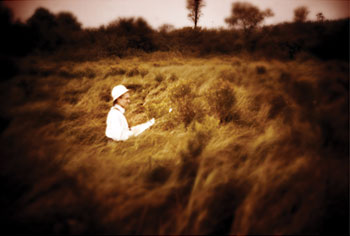
Andrey Avinoff at work in the field.
|



 A man of extraordinary intelligence, compulsively productive, and obsessed with the beauty of the exquisite, Avinoff became world-renowned for his scientific work on butterflies (see page 30). Some Pittsburghers were also aware of his artistic talent, as expressed in his occasional illustrations for CARNEGIE magazine and charming designs for Christmas cards, bookplates, banquet menus, and personal gifts. What they didn’t know is that before his appointment to the museum, Avinoff had made a living as a commercial illustrator, and that beginning in the 1930s, he began a second career, parallel to his day job at the museum, as a visionary artist.
A man of extraordinary intelligence, compulsively productive, and obsessed with the beauty of the exquisite, Avinoff became world-renowned for his scientific work on butterflies (see page 30). Some Pittsburghers were also aware of his artistic talent, as expressed in his occasional illustrations for CARNEGIE magazine and charming designs for Christmas cards, bookplates, banquet menus, and personal gifts. What they didn’t know is that before his appointment to the museum, Avinoff had made a living as a commercial illustrator, and that beginning in the 1930s, he began a second career, parallel to his day job at the museum, as a visionary artist. From the very beginning, Avinoff’s work served both art and science. Among his earliest surviving watercolors is a set of views made during his trips to collect butterflies in northern India, Kashmir, and western Tibet in 1908 and 1912. The view from the interior of his tent in the Karakoram Mountains artfully foregrounds the clutter of Western civilization—revolver, whiskey bottle, pith helmet, and leather-bound trunks—against a barren, pitiless background of rock and snow. Of no obvious scientific value, it provides a vivid sense of the experience of sitting in a canvas tent on a stony riverbank somewhere in the mountains of western Asia at the beginning of the 20th century. On the back of the sheet we discovered brilliantly colored drawings of butterfly wings, evidently made for study, arranged on the page with no concern at all for symmetry or aesthetics.
From the very beginning, Avinoff’s work served both art and science. Among his earliest surviving watercolors is a set of views made during his trips to collect butterflies in northern India, Kashmir, and western Tibet in 1908 and 1912. The view from the interior of his tent in the Karakoram Mountains artfully foregrounds the clutter of Western civilization—revolver, whiskey bottle, pith helmet, and leather-bound trunks—against a barren, pitiless background of rock and snow. Of no obvious scientific value, it provides a vivid sense of the experience of sitting in a canvas tent on a stony riverbank somewhere in the mountains of western Asia at the beginning of the 20th century. On the back of the sheet we discovered brilliantly colored drawings of butterfly wings, evidently made for study, arranged on the page with no concern at all for symmetry or aesthetics. 
 In spite of the progress we have made identifying elements of the triptych, we are still struggling to decipher its meaning. What do the flowers, moths, and butterflies symbolize? Are the atmospheric effects of clouds, rainbows, light, and dark significant? Do the floating soap bubbles allude to transience, as they had in the 1920s? How do we interpret the Christian and Buddhist symbols? Do the references to Tibet and New York and the River of Life relate to Avinoff’s travels and life story? We have, as yet, no idea.
In spite of the progress we have made identifying elements of the triptych, we are still struggling to decipher its meaning. What do the flowers, moths, and butterflies symbolize? Are the atmospheric effects of clouds, rainbows, light, and dark significant? Do the floating soap bubbles allude to transience, as they had in the 1920s? How do we interpret the Christian and Buddhist symbols? Do the references to Tibet and New York and the River of Life relate to Avinoff’s travels and life story? We have, as yet, no idea. America is a land of emigrants; people from everywhere sharing their talents and ideas. One remarkable contributor to this “melting pot” in Pittsburgh was Andrey Avinoff, a Russian emigré of great intellect, artistic ability, and linguistic facility. Avinoff led the renowned Carnegie Museum of Natural History as its director for nearly 20 challenging years of the Great Depression and Second World War, from 1926 to 1945. Arriving in Pittsburgh in 1924, Avinoff was recognized as a skilled curator of entomology and a talented illustrator of natural history subjects. Avinoff’s poise, wit, and cultural interests, coupled with his zeal for arts and natural history, made him an indispensable guest at social gatherings with museum benefactors and Pittsburgh’s cultural elite.
America is a land of emigrants; people from everywhere sharing their talents and ideas. One remarkable contributor to this “melting pot” in Pittsburgh was Andrey Avinoff, a Russian emigré of great intellect, artistic ability, and linguistic facility. Avinoff led the renowned Carnegie Museum of Natural History as its director for nearly 20 challenging years of the Great Depression and Second World War, from 1926 to 1945. Arriving in Pittsburgh in 1924, Avinoff was recognized as a skilled curator of entomology and a talented illustrator of natural history subjects. Avinoff’s poise, wit, and cultural interests, coupled with his zeal for arts and natural history, made him an indispensable guest at social gatherings with museum benefactors and Pittsburgh’s cultural elite. 
